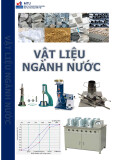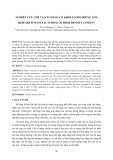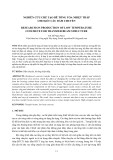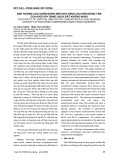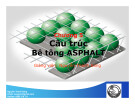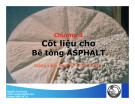
Journal of Science and Transport Technology Vol. 4 No. 2, 37-54
Journal of Science and Transport Technology
Journal homepage: https://jstt.vn/index.php/en
JSTT 2024, 4 (2), 37-54
Published online 26/06/2024
Article info
Type of article:
Review paper
DOI:
https://doi.org/10.58845/jstt.utt.2
024.en.4.2.37-54
*Corresponding author:
Email address:
hungnd85@utt.edu.vn
Received: 03/06/2024
Revised: 22/06/2024
Accepted: 24/06/2024
Effect of curing temperature on the
mechanical characteristics of cement-treated
soils: a review
Vinh Ngoc Chau1, Duy Hung Nguyen2,*, Son Ngoc Be3
1Department of Civil and Environmental Engineering, University of Michigan,
Ann Arbor, MI 48109, USA; email: cnvinh@umich.edu
2Faculty of Civil Engineering, University of Transport Technology, 54 Trieu
Khuc, Thanh Xuan, Hanoi, Vietnam; email: hungnd85@utt.edu.vn
3Administration Department, University of Transport Technology, 54 Trieu
Khuc, Thanh Xuan, Hanoi, Vietnam; email: sonbn@utt.edu.vn
Abstract: Nowadays, the treatment of soft soil with cement is gaining
popularity to meet the demands of construction development. Various factors,
including soil type, cement content and type, water-cement ratio, curing
conditions, and others, influence the effectiveness of this method in enhancing
soil mechanical properties. The impact of curing temperature on mechanical
properties is significant, and the curing temperature in cement-treated soil
typically increases due to the heat generated from cement hydration. This heat
is retained in the soil for an extended period, particularly in deep mixing
columns. This review summarizes the existing papers conducted regarding the
effect of curing temperature on cement-soil mechanical properties, focusing on
strength and stiffness. The present paper also includes strength prediction
models that consider the influence of curing temperature. In addition, the
Thermogravimetry analysis (TGA) used to determine the chemically bound
water content in cement-treated soil and the X-ray diffraction (XRD) test to
explain the chemical mechanism in cement-treated soil are also mentioned.
Keywords: strength, maturity, modulus of elasticity, cement-treated soil,
prediction model for strength.
1. Introduction
Cement-treated soils are integral to
construction, significantly enhancing the load-
bearing capacity, durability, and stability of soils
used in foundations, road bases, embankments,
and other civil engineering applications. This
treatment not only improves the soil's strength,
enabling it to support heavier loads and resist
deformation but also increases its durability,
making it more resistant to weathering and erosion
[1–5]. Additionally, cement-treated soils exhibit
reduced permeability [6], which prevents water
infiltration and mitigates internal erosion and
foundation problems. By stabilizing problematic
soils such as expansive clays, and loose sands,
cement treatment renders them more suitable for
construction, often resulting in cost savings by
reducing the need for imported high-quality fill
material. The effectiveness of cement-treated soils,
however, is influenced by various factors, including
soil type, the proportion of cement mixed, and
water content during mixing and curing, which
affect the hydration process of the cement [1],[2].
Moreover, curing time impacts the final strength,








